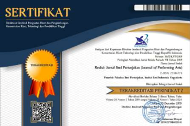The Children’s Songs Composition: A Contribution to Fill in The Absence of Children’s Songs in Indonesian Preschool Education
Abstract
Keywords
Full Text:
PDFReferences
Anagnostopoulou, C., Alexakis, A., & Triantafyllaki.(2012). A Computational Method for the Analysis of Musical Improvisations by Young Children and Psychiatric Patients with No Musical Background. International Conference on Music Perception and Cognition, 64–68.
Batey, M., & Furnham, A. (2006). Creativity, Intelligence, and Personality: A Critical Review of the Scattered Literature. Genetic, Social, and General Psychology Monographs, 132(4), 355–429. https://doi.org/10.3200/MONO.132.4.355-430
Campbell, P. S. (2002). Music education in a time of cultural transformation. Music Educators Journal, 89(1), 27–32. Csikszentmihalyi, M. (2014). The Systems Model of Creativity. Springer Netherlands. https://doi.org/10.1007/978-94-017-9085-7
Darling-Hammond, L., Flook, L., Cook-Harvey, C., Barron, B., & Osher, D. (2020). Implications for educational practice of the science of learning and development. Applied Developmental Science, 24(2), 97–140. https://doi.org/10.1080/10888691.2018.1537791
Davis, N., Winnemöller, H., Dontcheva, M., & Do, E. Y.-L. (2013). Toward a cognitive theory of creativity support. Proceedings of the 9th ACM Conference on Creativity & Cognition-C&C ’13, January 2015, 13. https://doi.org/10.1145/2466627.2466655
Denzin, N. K., & Lincoln, Y. S. (1994). Handbook of qualitative research. In Handbook of qualitative research. SAGE. http://www.uncg.edu/hdf/facultystaff/Tudge/Guba%20&%20Lincoln%201994.pdf
Dere, Z. (2019). Investigating the creativity of children in early childhood education institutions. Universal Journal of Educational Research, 7(3), 652–658. https://doi.org/10.13189/ujer.2019.070302
Gujjar, A. A., & Choudhry, B. N. (2009). Role of Teacher as Classroom Manager. In i-manager’s Journal on Educational Psychology (Vol. 2, Issue 4, pp. 65–73). https://doi.org/10.26634/jpsy.2.4.285
Hallam, S. (2010). The power of music: Its impact on the intellectual, social and personal development of children and young people. International Journal of Music Education, 28(3), 269–289. https://doi.org/10.1177/0255761410370658
Hattie, J., & Timperley, H. (2007). The Power of Feedback. Review of Educational Research, 77(1), 81–112. https://doi.org/10.3102/003465430298487
Ho, W. (2007). Students’ experiences with and preferences for using information technology in music learning in Shanghai’s secondary schools. British Journal of Educational Technology, 38(4), 699–714.
Peraturan Mentri Pendidikan dan Kebudayaan Republik Indonesia Nomor 137 Tahun 2014 Tentang Standar Nasional PAUD, Jakarta: Kemendikbud (2015).
Kozbelt, A. (2008). Review of Musical creativity: Multidisciplinary research in theory and practice. Psychology of Aesthetics, Creativity, and the Arts, 2(3), 181–182. https://doi.org/10.1037/1931-3896.2.3.181
Malloch, S., & Trevarthen, C. (2009). Musicality: Communicating the vitality and interests of life. Communicative Musicality: Exploring the Basis of Human Companionship, January 2009, 1–11.
Mang, E. (2005). The referent of children’s early songs. Music Education Research, 7(1), 3–20. https://doi.org/10.1080/14613800500041796
Mendecka, G. (1996). Development of Creativity Through Performing Arts. High Ability Studies, 7(2), 151–156. https://doi.org/10.1080/0937445960070205
Miles, M. B., & Huberman, A. M. (1994). Qualitative data analysis: An expanded sourcebook. sage.
Millington, N. T. (2011). Using Songs Effectively to Teach English to Young Learners. Language Education in Asia, 2(1), 134–141. https://doi.org/10.5746/leia/11/v2/i1/a11/millington
Murphey, T. (1992). The Discourse of Pop Songs Linked references are available on JSTOR for this article : 26(4), 770–774.
Niland, A. (2012). Exploring the Lives of Songs in the Context of Young Children ’ s Musical Cultures.
, 27–46.
Orkibi. (2011). Using Intermodal Psychodrama to Personalize Drama Students’ Experience: Two Case Illustrations. The Journal of Aesthetic Education, 45(2), 70. https://doi.org/10.5406/jaesteduc.45.2.0070
Parker, J. (2005). A Consideration of the Relationship Between Creativity and Approaches to Learning in Art and Design. International Journal of Art & Design Education, 24(2), 186–198. https://doi.org/10.1111/j.1476-8070.2005.00439.x
Pejić, A. (2016). The Effect of Using Songs On Young Learners and Their Motivation for Learning English Nihada Delibegović Džanić, University of Tuzla. An Interdisciplinary Journal, 1(2), 40–54. https://doi.org/10.24819/netsol2016.8
Porter, S., McConnell, T., McLaughlin, K., Lynn, F., Cardwell, C., Braiden, H., Boylan, J., Holmes, V., Group, M. in M. S., & Rogan, S. (2017). Music therapy for children and adolescents with behavioural and emotional problems: A randomised controlled trial. Journal of Child Psychology and Psychiatry, 58(5), 586–594.
Sarkar, J., & Biswas, U. (2015). The role of music and the brain development of children. ~ 107 ~ The Pharma Innovation Journal, 4(8), 107–111.
Shen, C. (2009). Using English Songs: an Enjoyable and Effective Approach to ELTUsing English Songs: an Enjoyable and Effective Approach to ELT. English Language Teaching, 2(1), 88–94. https://doi.org/10.5539/elt.v2n1p88
Topoğlu, O. (2014). Critical Thinking and Music Education. Procedia - Social and Behavioral Sciences, 116, 2252–2256. https://doi.org/10.1016/j.sbspro.2014.01.554
Torrance, E. P. (1984). The Role of Creativity in Identification of the Gifted and Talented. Gifted Child Quarterly, 28(4), 153–156. https://doi.org/10.1177/001698628402800403
Vygotsky, L. S. (2004). Imagination and Creativity in Childhood. Journal of Russian & East European Psychology, 42(1), 7–97. https://doi.org/10.1080/10610405.2004.11059210
Wadiyo, W. (2015). Music As An Integrated Education Tool for Preschool Students.
Harmonia: Journal of Arts Research and Education, 15(2). https://doi.org/10.15294/harmonia.v15i2.4691
Wong, Y. L., & Siu, K. W. M. (2012). A model of creative design process for fostering creativity of students in design education. International Journal of Technology and Design Education, 22(4), 437–450. https://doi.org/10.1007/s10798-011-9162-8
Wright, J. (1990). The Artist, the Art Teacher, and Misplaced Faith: Creativity and Art Education. Art Education, 43(6), 50–57. https://doi.org/10.1080/00043125.1990.11654304
Xhemajli, A. (2016). The role of the teacher in interactive teaching. International Journal of Cognitive Research in Science, Engineering and Education, 4(1), 31–38. https://doi.org/10.5937/IJCRSEE1601031X
Young, S. (2006). Seen but Not Heard: Young Children, Improvised Singing and Educational Practice. Contemporary Issues in Early Childhood, 7(3), 270–280. https://doi.org/10.2304/ciec.2006.7.3.270
DOI: https://doi.org/10.24821/resital.v22i3.6826
Refbacks
- There are currently no refbacks.
This work is licensed under a Creative Commons Attribution 4.0 International License.



